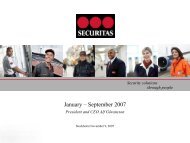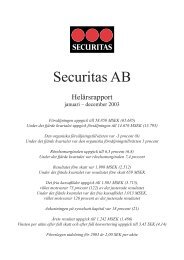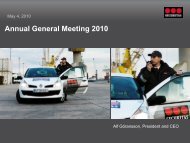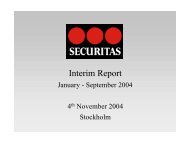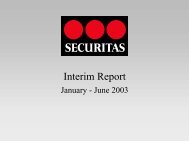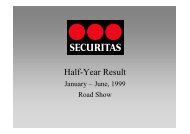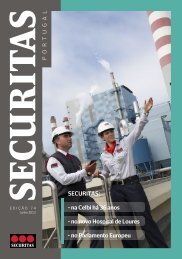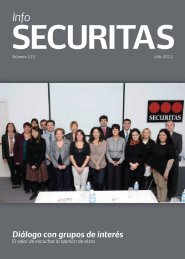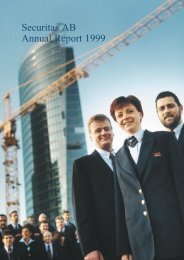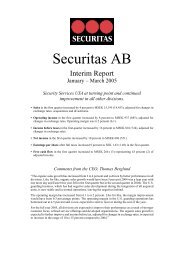Securitas AB Annual Report 2005
Securitas AB Annual Report 2005
Securitas AB Annual Report 2005
You also want an ePaper? Increase the reach of your titles
YUMPU automatically turns print PDFs into web optimized ePapers that Google loves.
Corporate Governance – <strong>Report</strong> of the Board of Directors – Internal control<br />
<strong>Report</strong> of the Board of Directors<br />
– Internal control<br />
Introduction<br />
The Board of Directors is, in accordance with the Swedish<br />
Companies Act and the Swedish Code of Corporate Governance,<br />
responsible for the internal control.<br />
This report has been prepared in accordance with section<br />
3.7.2 and 3.7.3 in the Swedish Code of Corporate Governance,<br />
and is therefore limited to internal controls over fi nancial reporting.<br />
This report does not form a part of the <strong>Annual</strong> Accounts.<br />
<strong>Securitas</strong>’ system of internal control is designed to manage<br />
rather than eliminate risk of failure to achieve business objectives<br />
and can only provide reasonable and not absolute assurance<br />
against material fi nancial reporting misstatement or loss.<br />
Control environment<br />
The Group has established a governance framework. The key<br />
features of the control environment within the framework include;<br />
the clear terms of reference of the Board and each of its<br />
committees, a clear organizational structure, with documented<br />
delegation of authority from the Board to Group Management,<br />
the quality of employees and a series of Group policies, procedures<br />
and frameworks.<br />
The overall Group operates in a fl at and specialized organization<br />
whereby managers are given clear objectives and are<br />
authorized to make their own decisions and develop their operations<br />
close to the customers. Delegation of authority is documented<br />
in an approval matrix that provides a clear direction for<br />
managers at all levels.<br />
Emphasis is placed on the quality and abilities of the Group’s<br />
employees with continuous education, training and development<br />
actively encouraged through a wide variety of schemes<br />
and programs. The Group has adopted a set of values to act as<br />
a framework for the employees to exercise judgment and make<br />
decisions on a consistent basis.<br />
The Group’s major fi nancial policies, procedures and frameworks<br />
include a comprehensive manual, “Financial Policies and<br />
Guidelines,” a <strong>Report</strong>ing Manual, the Six Fingers fi nancial model<br />
for fi nancial control, the Group Treasury Manual and the IT Security<br />
Manual. These are all periodically reviewed and updated.<br />
Risk assessment<br />
At the highest level, the Board considers where future strategic<br />
opportunities and risks lie every time it meets and helps shape<br />
the corporate strategy going forward. Accountability for managing<br />
operational risks is clearly assigned to the Group, Divisional<br />
and local management. The Group Management team has the<br />
day-to-day responsibility for the identifi cation, evaluation and<br />
management of risks and for the implementation and maintenance<br />
of control systems in accordance with the Board’s policies.<br />
Specifi cally, Divisional Management and established functional<br />
committees have the responsibility to ensure that there is a process<br />
throughout the division to create risk awareness. Operating<br />
unit managers and country risk managers are responsible for<br />
ensuring that risk management is part of the local corporate<br />
culture at all levels within a country.<br />
The Group has an established, but evolving, system of business<br />
risk management, which is integrated into the Group’s<br />
business planning and performance monitoring processes. Additionally,<br />
business risk evaluating workshops and risk reviews<br />
are conducted routinely throughout the Group. Procedures exist<br />
to ensure that signifi cant risks and control failures are escalated<br />
to Group Management and the Board, as necessary, on a periodic<br />
basis.<br />
Control activities<br />
Internal control covers all divisions and subsidiaries in the<br />
Group and includes methods and activities for securing assets,<br />
controlling the accuracy and reliability of internal and external<br />
fi nancial reports and ensuring compliance with defi ned guidelines.<br />
Self-assessment<br />
Every operating unit throughout the Group annually performs a<br />
self assessment control of the compliance with Financial Policies<br />
and Guidelines, the <strong>Report</strong>ing Manual and the IT Security<br />
Manual. An extensive questionnaire is used to measure to what<br />
extent defi ned requirements are fulfi lled. The self-assessment<br />
control is signed off by the President as well as the controller<br />
within the respective entities. As a part of the process, the<br />
external auditor performs a validation of the answers made in<br />
the questionnaire. Answers are compiled on a divisional level<br />
as well as on a Group level in order to support benchmarking<br />
within a division or between divisions. <strong>Report</strong>ed deviations<br />
include written comments on planned improvements to address<br />
deviations and a deadline for when planned actions will be in<br />
place. All reports are made available to Divisional Management,<br />
Group Management and the Audit Committee.<br />
Risk and control diagnostics<br />
The Group engages third parties to perform risk and control<br />
diagnostics in functional areas which by nature have high inherent<br />
risk – for instance the group’s major IT functions and treasury<br />
function. The fi ndings from these diagnostic reviews are made<br />
available to Group Management and the Audit Committee.<br />
Financial reporting<br />
Controllers at all levels have a key role in terms of integrity,<br />
professionalism and the ability to work in teams in order to<br />
create the environment that is needed to achieve transparent,<br />
relevant and timely fi nancial information. Local controllers<br />
within the divisions are responsible for ensuring compliance<br />
with the approved set of policies and frameworks and that internal<br />
control procedures in relation to fi nancial reporting are<br />
implemented. The controller is also responsible for reporting<br />
fi nancial information that is correct, complete and on time.<br />
In addition, each division has a Divisional Controller with<br />
corresponding responsibilities at an aggregated level.<br />
130 SECURITAS <strong>2005</strong>



